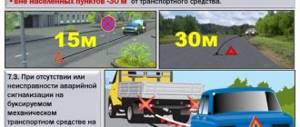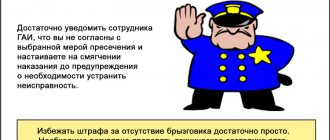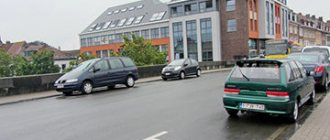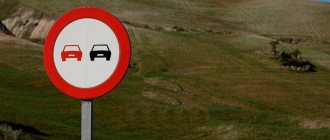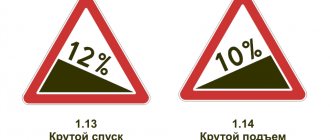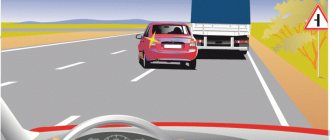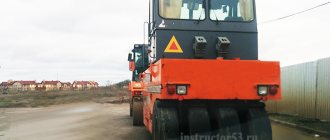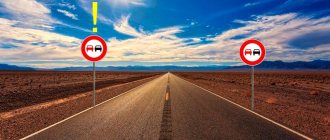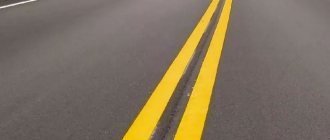Traffic rules, first published in the original version on November 22, 1993 in the 47th issue of the “Collection of Acts of the President and the Government of the Russian Federation” and approved by Decree of the Russian Government No. 1090 of October 23, 1993 “On the Rules...” (hereinafter referred to as the Rules), regulate the traffic order on Russian roads.
Dear readers! The article talks about typical ways to resolve legal issues, but each case is individual. If you want to find out how to solve your particular problem , contact a consultant:
+7 (499) 938-81-90 (Moscow)
+7 (812) 467-32-77 (Saint Petersburg)
8 (800) 301-79-36 (Regions)
APPLICATIONS AND CALLS ARE ACCEPTED 24/7 and 7 days a week.
It's fast and FREE !
The rules are mandatory for all motorists, vehicle passengers and pedestrians. Violation of regulations results in administrative and even criminal liability.
Definition
Despite the fact that such artificial objects as bridges are found quite often on highways, the definitions in clause 1.2. and is not presented in other paragraphs of the Rules.
But the definition is contained in the Great Soviet Encyclopedia: a bridge is an artificial structure that makes a path over some obstacle (usually water).
The bridge can be laid across any water body - be it an artificial or natural reservoir (rivers, lakes, ponds, etc.).
Objects such as overpasses and overpasses are similar in functionality:
- an overpass is a structure that, unlike a bridge, lays a road not through a water barrier, but through another road (road or railway - it doesn’t matter);
- An overpass is also an artificial structure through which a ravine or gorge can be driven.
The main difference between an overpass and an overpass is the possibility of access to other roads through the overpass and the lack of such access when driving along an overpass.
Despite the fact that the Rules do not contain definitions of a bridge, an overpass, or an overpass, they are still mentioned. In addition, the Rules clearly prohibit certain types of maneuvers at these facilities, and the Code of Administrative Offenses regulates liability for violation of these requirements.
The nuances of overtaking on a bridge
Bridges and overpasses can be classified as controversial areas. And where controversial issues arise, there is always a risk of abuse by traffic police inspectors. Many inspectors take advantage of drivers’ ignorance of their rights and issue fines for violating clause 11.4 of the traffic rules.
However, overtaking in an area marked with a “Name of Facility” sign is not in itself a violation.
- Not every crossing over a body of water is a bridge. You can overcome the obstacle along a dam or dam, overtaking on which is not regulated in the traffic rules. The bridge consists of supports and spans spanned between them. The set of safety elements located on spans is called a bridge deck. If at least one of the specified elements is missing, the structure is not a bridge. If there are no prohibiting signs or markings, then you can overtake in such a place.
- If there are continuous markings on the road surface of a structure, then its type does not matter. The penalty for overtaking in such a place would be absolutely legal.
- If the streams are separated by intermittent markings, then you need to look at the roadsides. Bridge structures are equipped with fences. If they are located less than 30 cm from the curb, then the dividing line must be solid. A mistake by road workers could result in the driver being fined. But in this case, the protocol can be challenged, focusing on incorrectly applied markings.
- Another important nuance is the length of the bridge. According to building codes, the length of the bridge is measured from the beginning of the span; transition slabs are not taken into account. The beginning of the side barriers does not mean that the driver managed to drive onto the bridge. Therefore, overtaking in such a place should be allowed.
Signs
Appendix 1 to the Rules contains a list of absolutely all signs used on Russian roads. However, this list does not include any sign indicating the presence of a bridge or the driver’s approach to it.
The only sign that somehow signals the presence of a bridge is 1.9. "Drawbridge". The presence of this sign indicates that the driver is soon approaching a drawbridge or ferry crossing.
“Ordinary” bridges are not indicated by any signs, so a motorist can determine whether it is a bridge or not only by indirect signs:
- by the presence of an information sign 6.11. “Name of object” - as a rule, the names of rivers, lakes or other water bodies are written on such signs, accordingly, there is a high probability that there is a bridge somewhere nearby;
- by the presence of markings 2.1.1., 2.1.2. or 2.1.3. – applied to overpass supports if such supports pose a danger to vehicles that have undergone technical inspection in the prescribed manner;
- by the presence of markings 2.2., which indicate the lower edge of the span of bridges and overpasses;
- visually - as a rule, all bridges are equipped with railings or metal bumpers.
Designation of the sign in the traffic rules
In the traffic rules there is no special sign indicating a bridge, except for sign 1.9 - drawbridge. Sometimes warning sign 1.33 - other hazards may be installed at the entrances to structures.
Sign 1.9 “Drawbridge”:
Sign 1.33 “Other hazards”:
If a bridge is installed over a river, then before it begins there should always be an information sign with the name of the river - this helps drivers understand that there is a bridge ahead, overtaking on which is strictly prohibited by traffic rules.
Sign 6.11 “Name of object”:
And yet, the most obvious sign that overtaking is prohibited is the presence of continuous markings instead of intermittent ones. In addition, when approaching the bridge, special barriers should appear - concrete or metal slabs that prevent driving beyond the road markings.
In the photo below there is a solid marking line:
Since there are various traffic violations when overtaking, we suggest reading about other possible fines: for overtaking on the side of the road, at an intersection, across a solid double line, crossing a solid marking line, under a “No Overtaking” sign, overtaking on the right, at a pedestrian crossing, double overtaking .
Which maneuvers are prohibited and which are allowed?
Artificial road structures, including bridges, overpasses and overpasses, are quite expensive to construct and operate. Therefore, during their construction, unnecessary costs are avoided in every possible way - in particular, they make the roadway narrow.
Because of this, motorists do not have the necessary space to maneuver, which entails a ban in the Rules on the implementation of most of them.
Stop
As stated in paragraph 1.2. Rules, stopping means stopping the movement of the vehicle:
- in general - for a period of no more than 5 minutes;
- or for any period at all, if the cessation of traffic is associated with the embarkation, disembarkation of citizens or the unloading (loading) of a vehicle.
In ab. 3 clause 12.4. The rules clearly state that stopping on bridges, overpasses and overpasses is prohibited. In addition, stopping under the bridge is also prohibited according to traffic regulations.
There is one exception - if there are 3 or more lanes for traffic in any direction, then stopping is permitted, but subject to the other provisions of Section 12 of the Rules.
In other words, if there are 3 lanes on an overpass or overpass, you can park the car on the right side of the road, and if there is no shoulder on the bridge, then at the edge of the roadway in one row. Only motorcycles without a side trailer can be parked in 2 rows.
Stopping on the left side is prohibited in any case, since vehicles can be parked there on roads with one lane, and if there is 1 lane on the bridge, then stopping is prohibited in any case in accordance with paragraph. 3 clause 12.4. Rules
Parking
Based on clause 12.5. The rules state that parking is not allowed in all those places where stopping is prohibited.
Thus, the above procedure also applies to parking - that is, parking on an overpass or overpass will be prohibited in the same cases as stopping (and, accordingly, permitted in cases where stopping is permitted).
Overtaking
Leading is considered to be the movement of a vehicle at a speed greater than the speed of the vehicle moving in the same direction.
By virtue of clause 1.2. According to the rules, overtaking means getting ahead of one or several cars at once, associated with driving into the oncoming lane, with a further return to the previously occupied lane.
According to ab. 5 clause 11.4. According to the rules, overtaking cannot be done under any circumstances, not only at signalized intersections and pedestrian crossings, but also on bridges, overpasses and under them.
In other words, drive into oncoming traffic on the bridge even if there is no sign 3.20. “Overtaking is prohibited” or continuous, strictly prohibited.
But with regard to advance, no prohibitions have been established. That is, a driver who has compulsory motor insurance can easily move in his lane at a speed higher than the speed of another vehicle moving in the same lane.
Features of overtaking at intersections according to traffic rules are discussed in the article: overtaking in traffic rules. Read about mandatory traffic rules signs here.
Rebuilding
Based on the same paragraph 1.2. According to the rules, changing lanes means leaving the originally occupied lane while maintaining the direction of movement.
In other words, changing lanes is changing lanes, for example, from the far right to the middle (if there are 3 lanes for driving in one direction).
If a bridge has several lanes for traffic in one direction, the driver can easily change lanes. There are no prohibitions on performing this maneuver in the Rules.
The procedure for rebuilding is the same as in other cases:
- giving the appropriate turn signal or making a hand gesture (clause 8.1 of the Rules);
- looking in the rearview mirror to make sure there are cars behind;
- the beginning of the maneuver, with the preliminary provision of priority to those vehicles moving in the lane that the driver with CASCO plans to occupy;
- If drivers change lanes at the same time, it is necessary to use the “right hand” rule - that is, give way to the vehicle on the right.
When changing lanes, the driver must also take into account the requirements presented in Section 9 of the Rules. Thus, if the bridge is located outside a populated area, it is prohibited to occupy the left lane if there are free right lanes (clause 9.4 of the Rules).
In addition, when there is heavy traffic on the bridge, changing lanes is allowed only for the following purposes:
- stops
- turning left or making a U-turn;
- around obstacles.
In addition, vehicles that, in accordance with technical capabilities, cannot reach a speed higher than 40 km/h (clause 9.6 of the Rules) are prohibited from changing lanes into any lane other than the far right lane.
U-turn
Based on ab. 4 clause 8.11. The rules are that you cannot make a U-turn on overpasses, overpasses, or in places located underneath them.
In addition, by virtue of ab. 2 clause 8.12. According to the rules, it is also prohibited to drive in reverse on bridges.
Permissible speed
Regulations regarding speed limits are given in Section 10 of the Rules.
There is no mention in this Section that drivers must adhere to a certain speed limit on bridges.
This means that the general order applies:
- if the bridge is located within a populated area, it is allowed to move along it at a speed not exceeding 60 km/h (clause 10.2 of the Rules);
- if the overpass or overpass is located outside the city boundaries, then the speed depends on the type of vehicle and the type of road - for example, on an overpass located on a highway, passenger cars can move at a speed of no more than 110 km/h, and on a bridge located on other roads outside cities - no more than 90 km/h.
Please note that the above permitted speeds are valid only in the absence of indicator 3.24. Its effect extends from its location to:
- or 1st intersection;
- or reaching the boundaries of a populated area.
The operation area of a speed limit sign may be limited to:
- plate 8.2.2.;
- or sign 3.25.;
- or a repeated sign 3.24., ordering to move at a different permitted maximum speed.
As we can see, if together with 3.24. 8.2.2 does not apply, then its operation on the bridge is not interrupted. So, if 3.24. installed before the overpass, the driver must drive at a speed no higher than that indicated on the sign.
Features of the convention
After leaving the bridge, the driver will be allowed to perform all maneuvers that were previously prohibited, namely overtaking, turning around, driving in reverse, stopping on the right side of the road, regardless of the number of lanes.
If, when exiting, oncoming traffic is difficult, the driver should be guided by the requirements of clause 11.7. Rules - that is, give way to an oncoming car if there is an obstacle on the driver’s side.
If immediately after the bridge there is a steep descent or ascent, indicated, respectively, by signs 1.13. and 1.14., the one who is moving downhill must yield.
What is the name of the bridge?
There are no special signs indicating the bridge specifically in the traffic regulations. The only exception is sign 1.9 “Drawbridge”. Therefore, it is impossible to determine with accuracy whether there is movement on the bridge or not. It is necessary to draw a conclusion from indirect signs.
Often bridges are bordered by barriers on both sides, and traffic lanes are separated by a solid line. However, you need to pay special attention to plate 1.33. This symbol warns of other hazards.
In front of a bridge across a river, there is always a sign with the name of that river. The beginning and end of the bridge are determined by the abutments - these are concrete structures that hold the embankment. You can also accurately identify the bridge by its continuous markings.
Fines for violating traffic rules
Depending on which paragraph of the Rules is violated by the motorist, one or another sanction will follow in accordance with the current edition of the Administrative Code:
- Turning around on an overpass or overpass, or in places located under them. Failure to comply with clause 8.11. of the Rules will entail a sanction in the form of a fine of 500 rubles in accordance with Part 2 of Art. 12.14. Code of Administrative Offences. The fine will be 250 rubles if paid within 20 days after the decision is issued.
- Turn around on a bridge located within the highway marked with sign 5.1. The fine for this violation is already 5 times greater - 2500 rubles (Part 3 of Article 12.11 of the Administrative Code).
- Moving backwards. The sanction is exactly the same as for a reversal - 500 rubles based on Part 2 of Art. 12.14. Code of Administrative Offences.
- Overtaking. The penalty is the same as for overtaking across a continuous road on other sections of the road, if it (overtaking) is prohibited in accordance with any paragraph of the Rules:
- or a fine of 5,000 rubles;
- or revocation of a driver's license for a period of 4 to 6 months.
If the traffic police inspector chooses deprivation of rights, the specific period of deprivation will be established by the court (Article 23.1 of the Administrative Code).
If you overtake on the bridge again (once again within 12 months - Article 4.6 of the Code of Administrative Offenses), then the sanctions will be much harsher - no alternative deprivation of rights for a period of 1 year. An exception is if repeated overtaking is recorded by a camera - then a fine of 5000 is imposed.
- Stopping or parking on an overpass or overpass. The punishment depends on the offense:
- if stopping or parking resulted in interference with the driving of other vehicles, sanctions will be imposed under Part 4 of Art. 12.19. Administrative Code - 2,000 rubles, and stopping or parking on a bridge that creates interference, if the bridge is located within the boundaries of a city of federal significance, is punishable by an increased fine of 3,000 rubles (Part 6, Article 12.19 of the Administrative Code);
- if the inspector did not notice the creation of obstacles to traffic, the punishment is imposed in accordance with Part 1 of Art. 12.19. Code of Administrative Offenses – warning or 500 rubles.
All traffic fines presented can be paid with a 50% discount.
- Violation of the established speed limit on the bridge. Responsibility is the same as for speeding in other situations, that is:
| How much was the speed exceeded from the maximum permitted, km/h | Types of punishment according to Art. 12.9. Code of Administrative Offenses |
| From 20 to 40 | 0.5 thousand rubles |
| From 40 to 60 | From 1 to 1.5 thousand. |
| Repeated from 40 to 60 | From 2 to 2.5 thousand. |
| From 60 to 80 | Or from 2 to 2.5 thousand, or cancellation of the temporary residence permit from 4 to 6 months |
| Repeated from 60 to 80 | Deprivation of rights for 1 year |
| From 80 and more | 5 thousand or cancellation of the license for 6 months |
| Repeated from 80 and over | Imprisonment for 1 year |
- Driving in an undesignated lane. If the driver takes, for example, outside a populated area on a bridge the left lane when the right one is free, sanctions will apply under Part 1 of Art. 12.15. Code of Administrative Offences—fine 1,500 rubles.
- The turn signal does not turn on when changing lanes. Responsibility will be under Part 1 of Art. 12.14. Code of Administrative Offenses – warning or 500 rubles.
So, in the Rules there is no definition of such concepts as a bridge, overpass, overpass, although at various points there is a ban on performing certain maneuvers in these places.
A motorist can distinguish a bridge from other objects both visually and by the presence of vertical markings 2.1.1. – 2.1.3. and 2.2., as well as an information sign with the name of the river (lake, reservoir).
Where is stopping and parking of vehicles prohibited according to traffic regulations? Find the answer in the article: stopping and parking in traffic rules. Check out the traffic prohibition signs here.
Turning left according to traffic rules is discussed on this page.
Penalty for overtaking on a bridge
According to clause 11.4 of the Russian Traffic Regulations, overtaking is prohibited on bridges, overpasses and overpasses. Responsibility for violating the rules of overtaking comes under Art. 12.15 Code of Administrative Offenses of the Russian Federation:
- according to paragraph 4 of Art. 12.15 driving into the oncoming lane is punishable by a fine of 5 thousand rubles. or deprivation of rights for up to six months;
- repeated violation is punishable by deprivation of rights for a period of 1 year;
- if a repeated violation was recorded by automatic photo and video cameras, the maximum sanction is a fine of 5 thousand rubles.
In the latter case, a reservation must be made. A fine is provided as a punishment only if the offense was recorded by cameras operating in automatic mode. If the moment of the violation was filmed by a traffic police inspector, then the recording will only become an additional argument for deprivation of rights.
